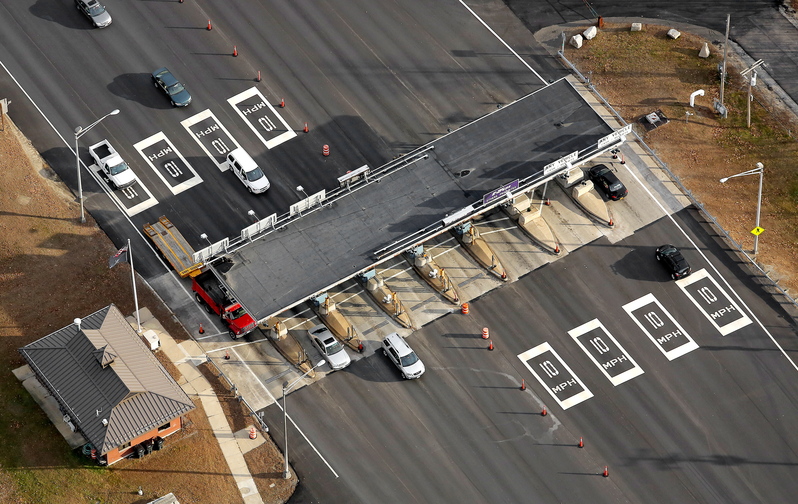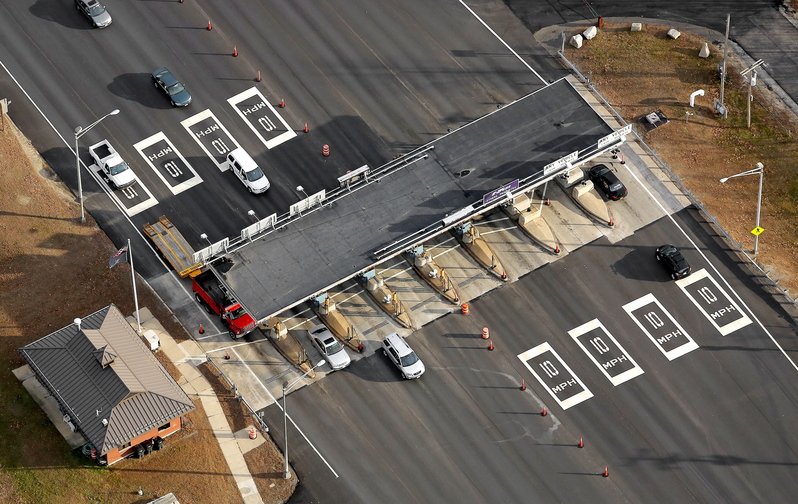Traffic on the Maine Turnpike decreased only slightly in the last 12 months, but revenue jumped 19 percent, thanks to a series of toll increases.
Data released to the Portland Press Herald on Thursday showed that the turnpike took in an extra $19.7 million from Nov. 1, 2012, through Oct. 31, 2013, thanks in large part to a strong second half of 2013. The traffic and revenue totals were just shy of projections and there is some evidence that motorists avoided some toll exchanges that saw increases.
In the first six months since tolls increased, revenue had increased by just 16 percent while transactions dipped 4 percent. In the tourist-heavy months of July, August, September and October, however, traffic on the turnpike was higher in 2013 than a year before.
Peter Mills, executive director of the Maine Turnpike Authority, said the numbers are encouraging, particularly because out-of-state motorists are picking up more of the share of tolls. In the year prior to the toll increases, 57 percent of revenue came from out-of-state travelers; in the year since, that number jumped to 63 percent. In fact, 41 percent of all toll revenue, about $54 million, now comes in through the York tollbooth alone.
“The shift was a little more pronounced than we thought it would be,” Mills said.
Turnpike officials first proposed toll increases in the summer of 2012. After months of discussion and feedback from the public, the board of directors voted in August.
Under the new toll rates — the 12th increase in the turnpike’s 66-year history — a cash trip for the length of the turnpike from York to Augusta increased from $5 to $7, while the most common cash toll for a standard commercial truck increased from $20 to $28 for the full route.
Cash tolls increased from $2 to $3 in York, from $1.75 to $2.25 at the New Gloucester plaza, from $1.25 to $1.75 at the West Gardiner plaza and from $1 to $1.50 at the northbound exit in Wells and the southbound exit in Gray. E-ZPass users saw an increase of 1 cent per mile traveled.
In conjunction with the toll increase, the turnpike authority also did away with a popular but inequitable commuter travel program. Now, E-ZPass users who travel frequently get a discount. Those who make between 30-39 trips per month get a discount of 25 percent; those who make 40 or more trips get a 50 percent discount. More than 10,000 E-ZPass users are getting a 25 percent discount and more than 26,000 are saving 50 percent.
Mills said the savings for E-ZPass users in the first year — $6.4 million — is more than triple the amount of savings achieved under the old commuter program.
Not everyone is paying less, though. Joe Thibeault, who lives in Saco and commutes to Portsmouth, N.H., every day for work, used to pay about $60 a month on the old commuter plan. Now, he said he pays between $70 and $80, after applying the 50 percent volume discount.
“I believe they did the fair thing. At least they listened to users,” he said.
Since the toll increase went into effect, the turnpike has signed up 36,000 new E-ZPass customers, bringing the total to more than 200,000.
Although the overall traffic decreased by only 1.5 percent, an analysis of traffic broken down by toll interchange suggests that motorists took steps to avoid some of the toll plazas that had increases.
The number of vehicles that passed through the New Gloucester toll decreased by 10 percent. The number at West Gardiner decreased by 6.5 percent. Both of those toll plazas saw toll increases.
The biggest drop was at the Falmouth spur exit, which lost 18 percent, although officials attributed that to a construction project on that stretch.
Traffic increased the most at exit 44 northbound, the exit that connects to toll-free Interstate 295. Roughly 5 percent more motorists passed through in the last 12 months than the 12 months before that.
The turnpike authority operates entirely on tolls and other revenue such as concessions. It receives no taxpayer money but does contribute 5 percent of its revenue to the Maine Department of Transportation.
For many years, ridership on the turnpike increased steadily by an average of 2.5 percent to 3 percent every year. Revenue increased at a similar rate.
That changed in 2008 when the economy soured and gas prices soared. Ridership and revenue flattened, then started to decline. Expenses, however, kept escalating.
Bob Stone, a board member from Lewiston, was the only member who opposed the toll increase. At the time, he said he didn’t feel the increases were equitable, particularly for people in Androscoggin County.
On Thursday, Stone said the toll increases have gone about as expected. They were projected to raise an extra $21 million and they took in almost $20 million.
Mills said last year that passing the latest toll increase should allow the turnpike to avoid future increases for the foreseeable future. He reiterated that Thursday.
“We anticipate being able to meet our capital needs with revenue and avoid future borrowing as well,” he said.
Staff Writer Eric Russell can be contacted at 791-6344 or at:erussell@pressherald.com Twitter: @PPHEricRussell
Send questions/comments to the editors.





Success. Please wait for the page to reload. If the page does not reload within 5 seconds, please refresh the page.
Enter your email and password to access comments.
Hi, to comment on stories you must . This profile is in addition to your subscription and website login.
Already have a commenting profile? .
Invalid username/password.
Please check your email to confirm and complete your registration.
Only subscribers are eligible to post comments. Please subscribe or login first for digital access. Here’s why.
Use the form below to reset your password. When you've submitted your account email, we will send an email with a reset code.